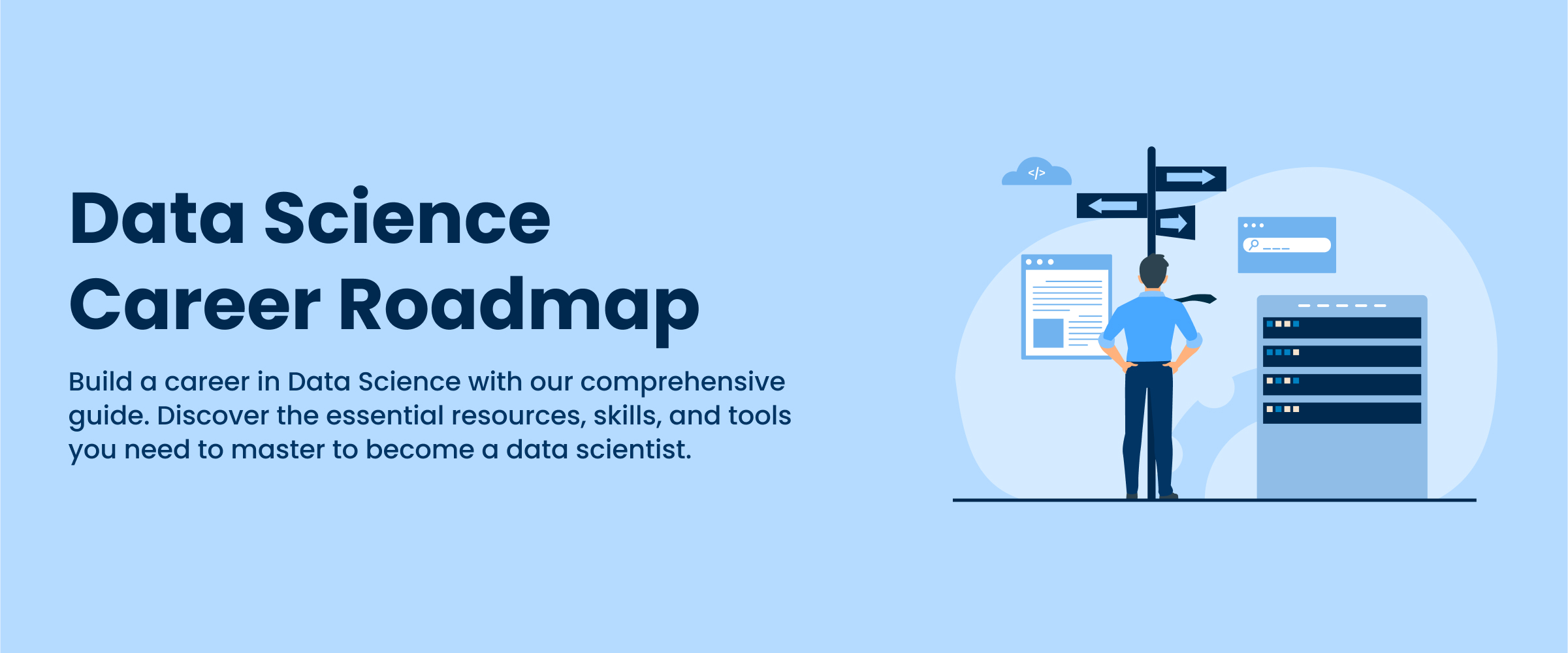Data Scientist Roadmap: Path to Success
According to a recent study, the employment of data scientists is expected to increase by 35% from 2022 to 2032. This highlights a positive job outlook for prospective candidates and current professionals, making data science one of the most sought-after and lucrative career fields. Data scientists play a crucial role in turning raw data into actionable information, enabling organizations to make informed decisions, optimize processes, and gain a competitive edge.
Due to this, the demand for professionals who can extract valuable insights from this data has skyrocketed. This comprehensive blog aims to provide a detailed data scientist roadmap, guiding you through the essential skills, tools, and knowledge required to excel in this field.
What Does a Data Scientist Do?
Data scientists are responsible for collecting, processing, and analyzing complex data sets to uncover meaningful patterns and insights. They specialize in data mining, statistical modeling, machine learning, predictive analytics, and data visualization. If you’re planning to build a career in this domain and don’t know where to start, check out this data science course with placement, which offers you essential knowledge of this field and comes with a job/internship guarantee.
The key responsibilities of a data scientist include:
- Data Collection and Processing: Collecting and processing large datasets from various sources.
- Data Cleaning: Cleaning, transforming, and preparing data for analysis.
- Analysis of Data: Applying statistical and machine learning techniques to identify patterns and trends within the data.
- Data Modelling: Building predictive models and algorithms to solve complex business problems.
- Communication with Stakeholders: Communicating findings and recommendations to stakeholders using data visualization techniques.
- Collaboration with Cross-functional Teams: Collaborating with cross-functional teams, such as business analysts, engineers, and subject matter experts, to identify and solve data-related challenges.
Comprehensive Data Scientist Roadmap for Beginners
Acquiring the right skills and qualifications is the foremost criterion for becoming a proficient data scientist. Here is a comprehensive data scientist roadmap to guide you through the journey.
1. Learn the Basics of Mathematics & Statistics
Data science heavily relies on mathematical and statistical concepts. A solid foundation in these areas is essential for understanding and applying data science techniques effectively. Start by mastering the following topics:
- Descriptive Statistics
- Probability
- Inferential Statistics (Hypothesis Testing, Confidence Intervals, etc.)
- Linear Algebra (Matrices and Vectors)
- Structured Thinking
Tip: To build a strong foundation in statistical analysis, an essential skill for data scientists, consider pursuing statistics for a data science course.
2. Master the Data Science Tools
To effectively analyze and manipulate data, you need to be proficient with the right data science tools and programming languages. The following are some essential tools that every aspiring data scientist should master.
i. Python Programming Fundamentals
Python has become the standard programming language in data science due to its simplicity, versatility, and extensive libraries for data analysis, machine learning, and visualization. Learning Python fundamentals and familiarizing yourself with Python’s libraries for data science will equip you with powerful tools for tackling a wide range of data science tasks.
ii. R programming
R is another popular programming language widely used in data science. It provides a comprehensive environment for statistical computing, data analysis, and visualization. Mastering R will enable you to use its extensive libraries and packages for advanced statistical modeling, data manipulation, and visualization techniques.
iii. Data Exploration, Wrangling, & Visualization
The data wrangling technique is used to transform and map raw data into a more organized and usable format by removing duplicates and correcting inconsistencies. This is done to avoid inaccurate results. Data exploration and visualization allow you to gain insights, identify patterns, and communicate findings to stakeholders effectively.
To gain expertise in various data cleaning and visualization tools, you can take up a SAS course or a Tableau course. Additionally, you can learn more about Power BI, a popular analytics tool.
3. Build Proficiency in SQL Queries and Database Skills
You should be proficient in using structured query language (SQL) to effectively interact with databases, retrieve data, and perform various data manipulation tasks. SQL skills are essential for querying databases, joining tables, filtering data, and aggregating information. Mastering SQL will enable you to efficiently extract, manipulate, and prepare data for further analysis and modeling.
Additionally, understanding database concepts, such as data normalization, indexing, and database design principles, will help you work with large data sets more effectively. To develop proficiency in structured query language, take up a SQL for data analytics course and learn essential functions, commands, and operations.


4. Gain Expertise in Machine Learning Tools
Machine learning is a core component of data science, encompassing a wide range of algorithms and techniques for building predictive models, uncovering patterns, and making data-driven decisions.
Mastering the following machine learning applications, concepts, and tools is essential for tackling various real-world problems and challenges.
- Exploratory Data Analysis (EDA) and Data Cleaning: Study datasets through summarization and visualization to identify patterns. Clean data by handling errors, and missing values, and ensuring integrity. Proficiency in EDA and cleaning prepares high-quality data for modeling.
- Feature Selection and Engineering: Identify and select relevant features from datasets through feature selection. Create new features by transforming or combining existing ones through feature engineering.
- Model Selection: Choose appropriate machine learning algorithms based on the problem type. Some popular statistical models include:
- Linear Regression
- Logistic Regression
- Decision Trees
- K-Nearest Neighbor (KNN)
- K-Means
- Naïve Bayes
- Dimensionality Reduction
- Random Forests
- Gradient Boosting Machines
- Support Vector Machines
- Model Evaluation: Assess model performance using techniques like holdout sets and cross-validation to ensure generalization capability and reliability.
If you wish to review your basic and advanced machine-learning concepts before an interview, check out the top machine learning interview questions and answers. Alternatively, if you are looking to build a strong foundation in the ML domain, consider pursuing a machine learning course.
5. Develop Skills in Deep Learning and Natural Language Processing (NLP)
Deep learning is a subset of machine learning and has gained significant popularity due to its remarkable performance in various domains, such as natural language processing and speech recognition. Natural Language Processing (NLP) is also a critical aspect of data science that focuses on the interaction between computers and human language. NLP techniques enable you to perform tasks, such as sentiment analysis, text classification, named entity recognition, topic modeling, and language translation.
6. Learn Deployment and Cloud Platforms
Understand how to deploy your models and applications. Cloud platforms have become increasingly popular for deploying and scaling data science solutions, offering scalability, flexibility, and cost-effectiveness.
Some popular cloud platforms to learn include Amazon Web Services (AWS), Microsoft Azure, and Google Cloud Platform.
7. Build Projects & a Portfolio with Github
Building projects and maintaining a portfolio on platforms like GitHub will not only reinforce your learning but will also showcase your skills and accomplishments to potential employers. Start by working on small, focused projects that demonstrate your proficiency in specific areas. Your portfolio should include well-documented code, clear explanations of the problem statements, methodologies used, and insights gained.
If you’re looking for project ideas, check out data science projects. Further, to learn how to collaborate on projects and employ version control, you can pursue a short Git and GitHub course.
8. Apply for Internships & Fresher Jobs
Internshala is one of the leading hiring portals in India. It is trusted by over 300+ companies who are currently looking for their next employee across different profiles. As a job seeker, you can easily browse and discover suitable data science internship opportunities and job vacancies according to your preferences. Additionally, you can set an alert for your search combinations to receive regular updates about new openings.
Career Prospects in Data Science
Before you begin searching for a suitable job, it is essential to explore various data science career prospects. Here are some job roles you can apply for in this domain:
- Junior Data Scientist
- Data Engineer
- Data Analyst
- Business Intelligence Analyst
- Machine Learning Engineer
- Data Architect
- Database Administrator
Conclusion
Becoming a proficient data scientist is a journey that requires dedication, continuous learning, and practical experience. By following this data scientist roadmap, you will acquire the necessary skills and knowledge to excel in the data science field. Whether you are a recent graduate, a professional seeking a career transition, or someone with an interest in data analysis, this roadmap for data scientists will serve as a valuable resource on your journey to becoming a data scientist.






